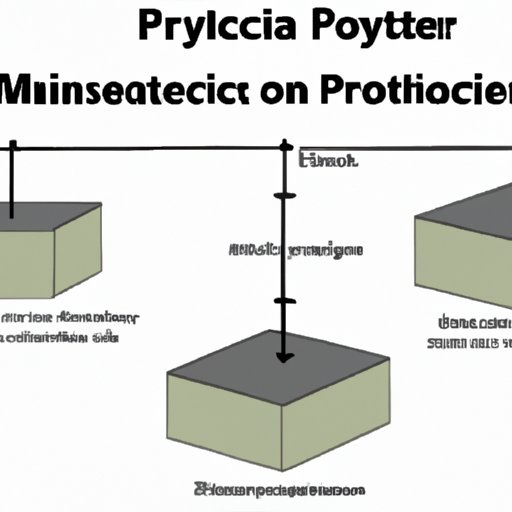Introduction
Physical properties are the defining characteristics of matter that scientists and engineers use to describe and measure the properties of materials. Understanding physical properties is essential in various fields, including material science, physics, and chemistry. They play a central role in scientific research, engineering, and product design.
This article will explore the meaning of physical properties and cover the different characteristics of physical properties. It will also provide practical and accessible information on how to measure physical properties of substances in the laboratory, as well as distinguish physical properties from chemical properties.
Defining Physical Properties: A Basic Guide
Physical properties refer to the properties of a material that can be measured and observed without changing the chemical composition or identity. These properties are fundamental in the study of chemistry, material science, and physics, where they provide insight into the behavior and composition of matter.
Unlike chemical properties, which involve the chemical reaction or change in composition, physical properties do not cause the substance to change. Physical properties are used to describe a substance’s characteristics, including size, shape, volume, mass, and density, as well as any other visible or measurable qualities.
Exploring the Characteristics of Physical Properties
Physical properties possess various characteristics that differentiate them from chemical properties. The following are some key features of physical properties:
Reproducibility: Physical properties of a substance are reproducible, and any change to the sample’s conditions will have a predictable effect on its physical characteristics.
Objectivity: Physical properties of a substance are objective, meaning the properties are factual and do not depend on the observer’s subjective opinion.
Quantitative: Physical properties of a substance can be measured quantitatively. For instance, the density of a substance is expressed in terms of units of mass per unit volume.
Qualitative: Physical properties of a substance can be qualitatively assessed based on the five senses of sight, sound, touch, smell, and taste.
Understanding the Role of Physical Properties in Science and Engineering
Physical properties have significant applications in the fields of science and engineering. Scientists and engineers use physical properties to classify, identify, and design different materials, products, and systems. Physical properties are crucial in various industries like automotive, pharmaceuticals, construction, and manufacturing.
Physical properties have diverse applications in various fields of engineering. For example, civil engineers use physical properties to determine building materials’ strength, durability and stretching capabilities. Similarly, electrical engineers make circuits using materials that possess specific physical properties that suit specific applications. Physicists use physical properties to design experiments that test their hypotheses, while chemists use physical properties to investigate chemical compounds and their interactions.

Common Examples of Physical Properties in Everyday Life
Physical properties are prevalent in our daily lives, from the color and texture of our clothes to the shape and size of our furniture and kitchen appliances. Examples of physical properties that people encounter in their daily lives include size, shape, color, texture, sound, and smell.
People use physical properties in their daily lives to evaluate different products’ quality and functionality. For instance, a buyer may select a shirt with a soft texture because it feels more comfortable or choose vegetables based on their color, texture, and size.
The Importance of Measuring Physical Properties in Materials Science
Measuring physical properties is essential in Material Science because it determines the quality and performance of different materials. Measurements provide a way to determine materials’ resistance to heat, wear, and pressure, which is vital in the production of durable, safe, and sustainable materials.
Materials scientists use physical properties to evaluate new materials, identify the defects and imperfections, and determine the most effective way to modify the material’s properties to meet specific requirements. Additionally, measurements enable the scientific community to compare the properties of different materials, laying the foundation for future discoveries and advances in Material Science.
How to Determine Physical Properties of Substances: Techniques and Tools
Determining physical properties requires the use of various techniques and tools, which vary depending on the type of property being measured and the substance’s characteristics. Below is a guide on how to determine the most common physical properties of substances:
Mass: Measured using a balance or scale, mass is the amount of matter in an object.
Volume: Measured using a graduated cylinder or volumetric container, volume is the amount of space an object takes up.
Density: Measured using a balance and a graduated cylinder, density is the mass per unit volume of a substance.
Temperature: Measured using a thermometer, temperature is the degree of hotness or coldness of a substance
Comparing Chemical and Physical Properties: What’s the Difference?
Physical properties and chemical properties are both used to describe matter, but they differ in the nature of the characteristics they describe. Physical properties are observable characteristics that describe matter’s behavior and appearance without changing its molecular structure. Conversely, chemical properties are characteristics of matter that describe its ability to undergo a chemical reaction or chemical change.
Physical properties include color, shape, and size, while chemical properties include acidity, flammability, and reactivity. Lastly, physical properties are measurable, objective, and reproducible across samples, but chemical properties change the fundamental identity of the substance and are therefore not reproducible across different molecules or samples.
Conclusion
In conclusion, understanding physical properties is crucial in scientific research, engineering, and product design. Physical properties have objective, measurable, qualitative, and quantitative characteristics that differentiate them from chemical properties. Measuring physical properties allows Materials Scientists to study materials that demonstrate desirable characteristics like hardness, wear resistance, and flexibility required for a specific application. Additionally, knowledge of physical properties helps us make informed decisions when purchasing products or solving everyday problems.
